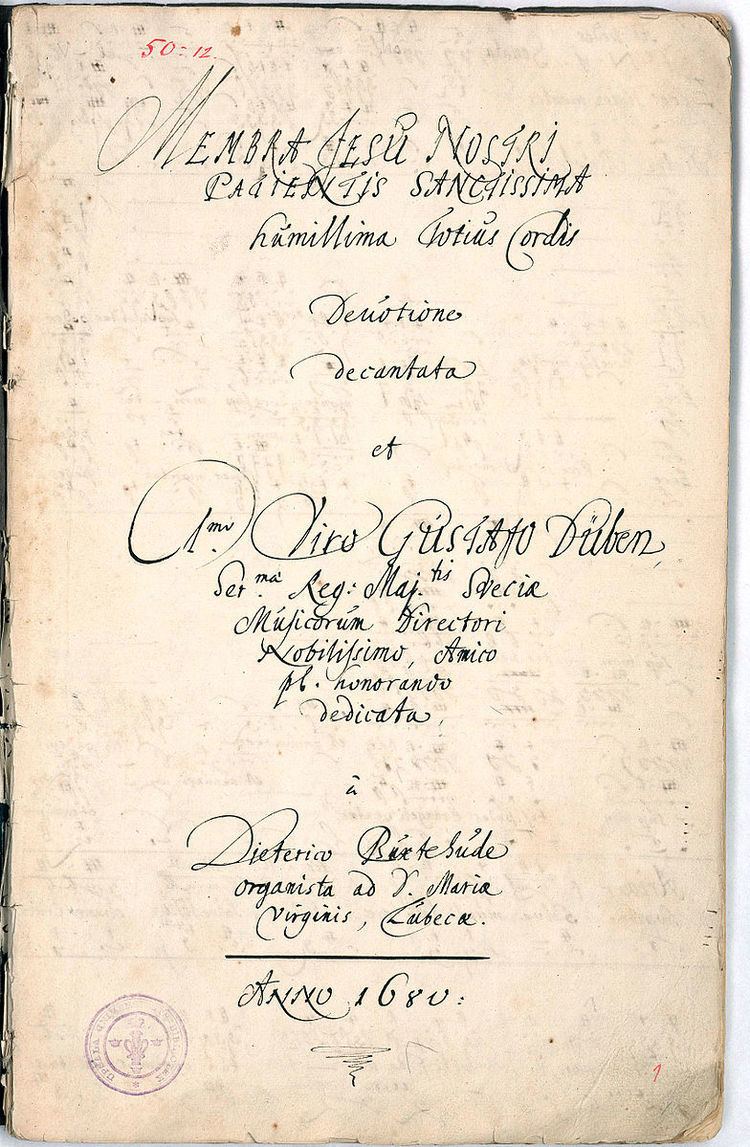Catalogue BuxWV 75 | Composed 1680 (1680) | |
 | ||
Full Membra Jesu nostri patientis sanctissima English The most holy limbs of our suffering Jesus Text BibleRhythmica oratio by Arnulf of Leuven | ||
Membra Jesu Nostri (English: The Limbs of our Jesus), BuxWV 75, is a cycle of seven cantatas composed by Dieterich Buxtehude in 1680, and dedicated to Gustaf Düben. The full Latin title Membra Jesu nostri patientis sanctissima translates to "The most holy limbs of our suffering Jesus". This work is known as the first Lutheran oratorio. The main text are stanzas from the Medieval hymn Salve mundi salutare – also known as the Rhythmica oratio – a poem formerly ascribed to Bernard of Clairvaux, but now thought more likely to have been written by Medieval poet Arnulf of Leuven (died 1250). It is divided into seven parts, each addressed to a different part of Christ's crucified body: feet, knees, hands, sides, breast, heart, and head. In each part, biblical words referring to the limbs frame verses of the poem.
Contents
Structure
Each cantata in Membra Jesu Nostri is divided into six sections; an instrumental introduction; a concerto for instruments and five voices (SSATB), with the exception of the fifth and sixth cantatas where only three voices are used; three arias for one or three voices, each followed by an instrumental ritornello; and an exact reprise of the concerto. The first and the last cantata of the cycle deviate from this pattern. In the first cantata the choir repeats the first aria after the reprise, in the last one, Ad faciem, 5 parts sing the last aria, and then a final Amen instead of the reprise concludes the cycle.
The structure of Membra is dictated by its text. Buxtehude selected biblical verses for the concertos, and three strophes from each part of the poem Salve mundi salutare for the arias in each cantata. The biblical words are chosen for mentioning the member of the cantata and taken mostly from the Old Testament. The metre of the poetry unifies the arias' rhythmic patterns.
Example 1 (in bold are stressed syllables):Cantatas
The work is scored for five voices SSATB who may also form the choir, two violins and basso continuo. A viola da gamba consort is called for only in part VI, Ad cor, to the heart.
The following table shows for each cantata the title and its translation, Tempo marking, the voices (SATB, first for the choir, then for the arias, with S2 for the second soprano), the Baroque instruments of two violins (Vl) and five violas da gamba (Vg), and the biblical text source for the concerto. The source for the arias is always Salve mundi salutare. The continuo, playing throughout, is not shown.
I Ad pedes
(To the feet)
1 Sonata (instrumental introduction)II Ad genua
(To the knees)
1 SonataIII Ad manus
(To the hands)
1 SonataIV Ad latus
(To the sides)
1 SonataV Ad pectus
(To the breast)
1 SonataVI Ad cor
(To the heart)
In this part a consort of viola da gamba replaces the violins.
1 SonataVII Ad faciem
(To the face)
1 Sonata